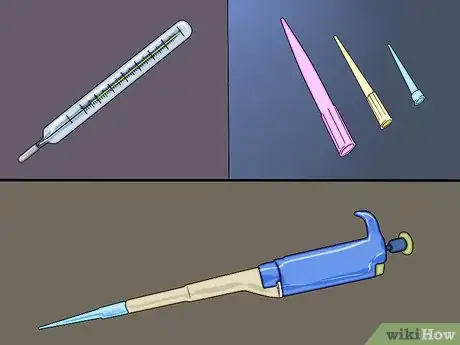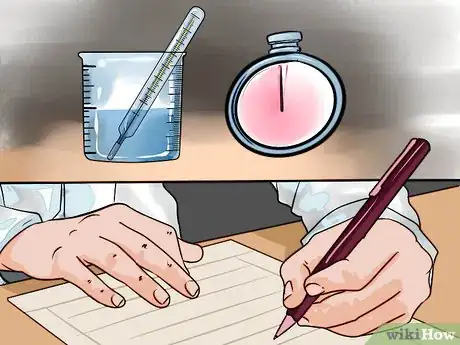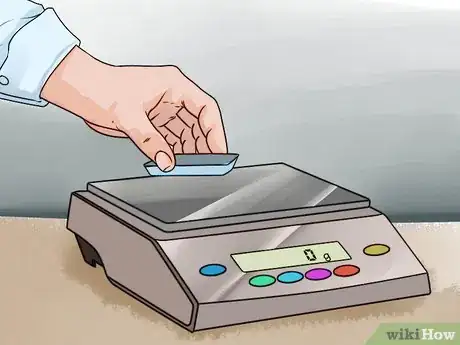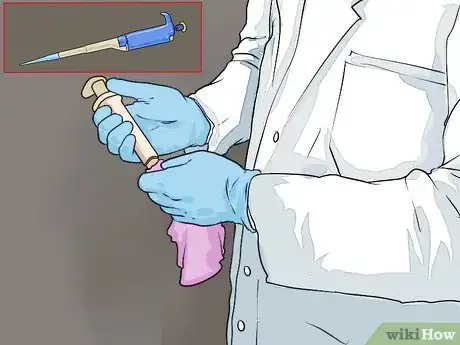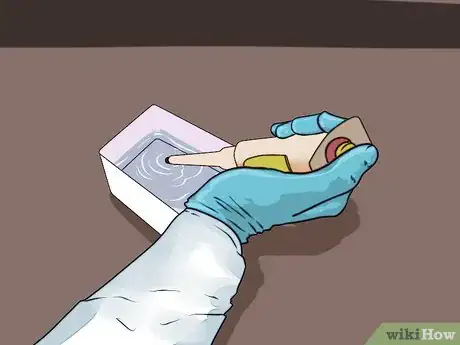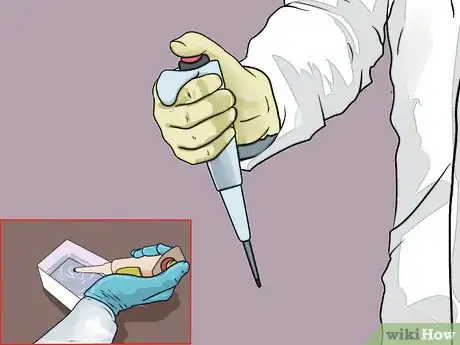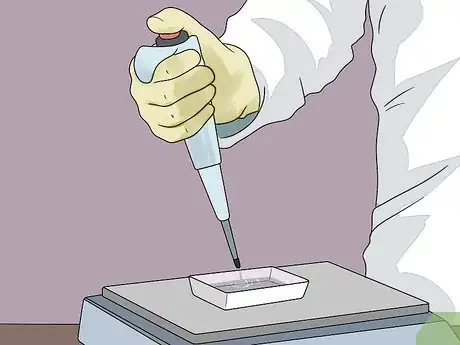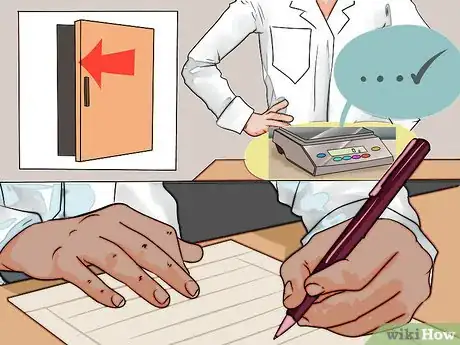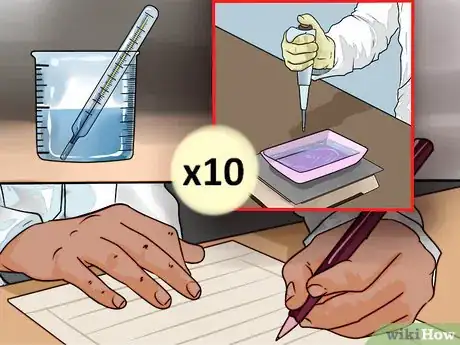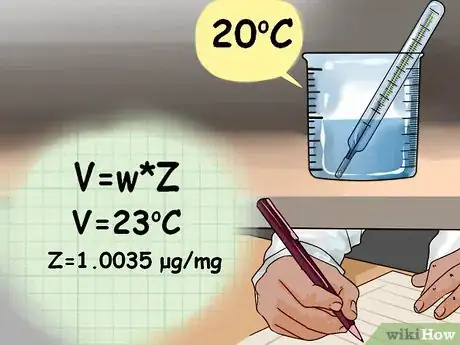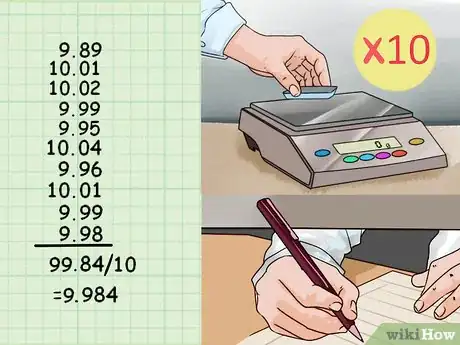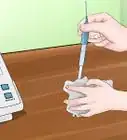This article was co-authored by Meredith Juncker, PhD. Meredith Juncker is a PhD candidate in Biochemistry and Molecular Biology at Louisiana State University Health Sciences Center. Her studies are focused on proteins and neurodegenerative diseases.
wikiHow marks an article as reader-approved once it receives enough positive feedback. This article received 12 testimonials and 92% of readers who voted found it helpful, earning it our reader-approved status.
This article has been viewed 284,931 times.
Pipettes are a type of lab equipment used to measure and transfer very small volumes of liquid. Accuracy and precision in pipette measurement are necessary as any discrepancy in volumes dispensed can affect the results of an experiment. To ensure accuracy, it is necessary to check the pipette calibration every few months. The calibration process helps to check whether or not the equipment is dispensing the proper volumes so it can be fixed if it is not.
Steps
Checking the Calibration
-
1Gather the necessary materials. To check the calibration of a pipette, you will need the pipette, pipette tips, distilled water, a beaker, a thermometer, a balance, and weigh boats. The balance needs to be specific to micrograms to calibrate micropipettes with a maximum of 1 µL.[1]
- You won’t need more than 5 mLs of water. Fill the beaker with the water.
- Make sure the pipette tips are the correct tips that properly fit the pipette.
-
2Measure the temperature of the distilled water. Place the thermometer in the water and leave it for at least one minute. If the red line on the thermometer is still moving, leave it for another minute. After a minute, record the temperature in a notebook. Remove the thermometer and dry it off when you are finished.[2]
- Knowing the temperature of the water is important for the calculations that will be done to check the calibration.
Advertisement -
3Place the weigh boat on the balance and zero it out. Ideally, you will use a balance that has doors on it and is an isolated chamber. Place the weigh boat in the chamber and close the doors. If you don’t have doors, simply place the weigh boat on the balance. Press the “Zero” or “Tare” button and wait until the balance reads zero.[3]
- Zeroing the scale subtracts the weight of the plastic boat and allows you to measure just the weight of whatever you put into the boat.
-
4Prepare the pipette for calibration. Wipe down the pipette with ethanol to kill any contaminants before beginning and make sure nothing is clogging the tip end of the pipette. Place the appropriate tip on the end and set the volume that you want to test.[4]
- For calibration, test both the smallest volume and the largest volume the pipette can dispense.
-
5Pre-rinse the tip before calibration. Press the button to the first stop and stick the tip into the distilled water so that about 2 mm is immersed in the liquid. Release the button to aspirate some liquid and then dispense the liquid again by pushing the button down. Repeat this three times to pre-rinse the tip.[5]
- Push the button to the second stop to dispense any liquid that remains in the tip and remove the pipette from the water.
-
6Aspirate the calibration volume. With the tip out of the liquid, push the button down to the first stop. Place about 2 mm of the tip into the distilled water and release the button to aspirate the liquid into the tip. Wait about 1 second before removing the tip from the water.[6]
- Make sure the tip is completely immersed during the whole aspiration process. You don’t want any bubbles in the tip or the results will be wrong.
-
7Dispense the liquid into the weigh boat on the scale. Place the tip against the bottom of the weigh boat and push the button down to the first stop. Move to another spot slightly away from the water and push the button to the second stop. Keeping the button pressed, lift the tip away from the weigh boat.[7]
- Keep the tip on the pipette as you will use it again to weigh out more calibration tests. MAke sure the tip does not touch anything.
-
8Record the weight on the balance. Close the door if you are using a chamber balance. Wait until the numbers stop changing. Record this number in your notebook.[8]
- It’s important to wait until the number has stabilized before recording it. Your readings will be incorrect if you don’t wait.
-
9Repeat this process to take at least 10 readings. Zero the scale, pre-rinse the tip, aspirate the same volume, dispense the volume, and then record the weight. You want to have multiple recordings of the same volume and then you can average them all together.[9]
- You can repeat this same process with different volumes as long as you take multiple readings per volume.
Calculating the Results
-
1Define the formula for calculated volume. The formula for calculating the volume dispensed by the pipette is V = w * Z where w is the weight of the water, Z is the conversion factor based on the density of the water, and V is the calculated volume of how much water was dispensed.
- You can find the Z variable by looking up the density of water using the temperature recorded at the beginning of the experiment.[10]
- For example: If the temperature of the water was 23°C, then you will use a Z value of 1.0035 µg/mg.
-
2Average the replicates together. You should have weighed the volume of water dispensed by the pipette at least 10 times. In order to average all of these values together, add them all up and divide by 10. If you did more or fewer trials, add up each trial and divide by the total number of trials.[11]
- For example: The ten weights you recorded for a pipette volume of 10µL are as follows: 9.89, 10.01, 10.02, 9.99, 9.95, 10.04, 9.96, 10.01, 9.99, and 9.98.
- The average is: (9.89 + 10.01 + 10.02 + 9.99 + 9.95+ 10.04 + 9.96 + 10.01 + 9.99 + 9.98)/10 = 99.84/10 = 9.984
-
3Plug the variables into the equation and solve. Once you have determined the proper numbers to use for each variable, you can plug them into the equation and solve for the calculated volume. To solve, simply multiply the average weight of all the trials by the Z value.
- For example: V = w * Z = 9.984 * 1.0035 = 10.019
-
4Calculate the accuracy of the pipette. To calculate the accuracy you can use the equation A = 100 x Vavg/V0, where A is the accuracy of the pipette, Vavg is the average calculated volume and V0 is the value you set the pipette to dispense. Accuracy should be between 99-101%.[12]
- If the pipette is properly calibrated, the calculated value should be very close to the actual value you set on the pipette.
- For example: A = 100 x Vavg/V0 = 100 x 10.019/10 = 100 x 1.0019 = 100.19%
- This particular pipette is properly calibrated.
-
5Send the pipette for calibration, if necessary. If your pipette does not pass the calibration test, stop using it for experiments immediately. Pipettes are very delicate and expensive pieces of lab equipment. You cannot fix the calibration yourself so you will need to send them in for proper servicing. Alternatively, some companies will come to your lab and calibrate your pipettes there
- Contact the company that makes your particular brand of pipette for servicing.
Expert Q&A
Did you know you can get expert answers for this article?
Unlock expert answers by supporting wikiHow
-
QuestionWhy is pipette calibration important?
 Meredith Juncker, PhDMeredith Juncker is a PhD candidate in Biochemistry and Molecular Biology at Louisiana State University Health Sciences Center. Her studies are focused on proteins and neurodegenerative diseases.
Meredith Juncker, PhDMeredith Juncker is a PhD candidate in Biochemistry and Molecular Biology at Louisiana State University Health Sciences Center. Her studies are focused on proteins and neurodegenerative diseases.
Scientific Researcher
-
QuestionHow do I calibrate the instrument for use at a temperature of 24 degrees Celsius?
 Meredith Juncker, PhDMeredith Juncker is a PhD candidate in Biochemistry and Molecular Biology at Louisiana State University Health Sciences Center. Her studies are focused on proteins and neurodegenerative diseases.
Meredith Juncker, PhDMeredith Juncker is a PhD candidate in Biochemistry and Molecular Biology at Louisiana State University Health Sciences Center. Her studies are focused on proteins and neurodegenerative diseases.
Scientific Researcher If the distilled water you used was 24 degrees Celsius at atmospheric pressure, your Z value would be 1.0038 µg/mg. Multiply these two values together (w*Z) to obtain your V value, or volume of water dispersed. This V value you just calculated is your Vavg. Divide Vavg/Vo (the amount you're theoretically pipetting, in this case it would be 1mL) and multiply this number by 100. That will be your accuracy percentage. Any answer between 99-101% is properly calibrated.
If the distilled water you used was 24 degrees Celsius at atmospheric pressure, your Z value would be 1.0038 µg/mg. Multiply these two values together (w*Z) to obtain your V value, or volume of water dispersed. This V value you just calculated is your Vavg. Divide Vavg/Vo (the amount you're theoretically pipetting, in this case it would be 1mL) and multiply this number by 100. That will be your accuracy percentage. Any answer between 99-101% is properly calibrated. -
QuestionDoes this process apply to fast release pipette pumps?
 Meredith Juncker, PhDMeredith Juncker is a PhD candidate in Biochemistry and Molecular Biology at Louisiana State University Health Sciences Center. Her studies are focused on proteins and neurodegenerative diseases.
Meredith Juncker, PhDMeredith Juncker is a PhD candidate in Biochemistry and Molecular Biology at Louisiana State University Health Sciences Center. Her studies are focused on proteins and neurodegenerative diseases.
Scientific Researcher
References
- ↑ http://g6pd.qap.tw/Pipette%20calibration.pdf
- ↑ https://www.depts.ttu.edu/meatscience/docs/Calibrating-a-Pipette-7-23-20.pdf
- ↑ https://www1.nyc.gov/assets/ocme/downloads/pdf/QAQC%20-%20J%20-%20Pipette%20Calibration%20Procedure.pdf
- ↑ http://g6pd.qap.tw/Pipette%20calibration.pdf
- ↑ https://www.depts.ttu.edu/meatscience/docs/Calibrating-a-Pipette-7-23-20.pdf
- ↑ http://g6pd.qap.tw/Pipette%20calibration.pdf
- ↑ http://g6pd.qap.tw/Pipette%20calibration.pdf
- ↑ https://www.depts.ttu.edu/meatscience/docs/Calibrating-a-Pipette-7-23-20.pdf
- ↑ https://www1.nyc.gov/assets/ocme/downloads/pdf/QAQC%20-%20J%20-%20Pipette%20Calibration%20Procedure.pdf
About This Article
To calibrate a pipette, place a clean weigh boat on a scale and hit “zero” so you don’t record the weight of the boat. Then, wipe the pipette down with ethanol to sterilize it. Once the device is sterile, pre-rinse the tip by pushing the button to the first stop and sticking it into the liquid. Release the button and press it again 3 times to pre-rinse the tip. Next, draw out 2 stops of water and put them in the boat and weigh them. Take 10 measurements like that to check the calibration. For tips from our Medical reviewer on checking the results, scroll down!
